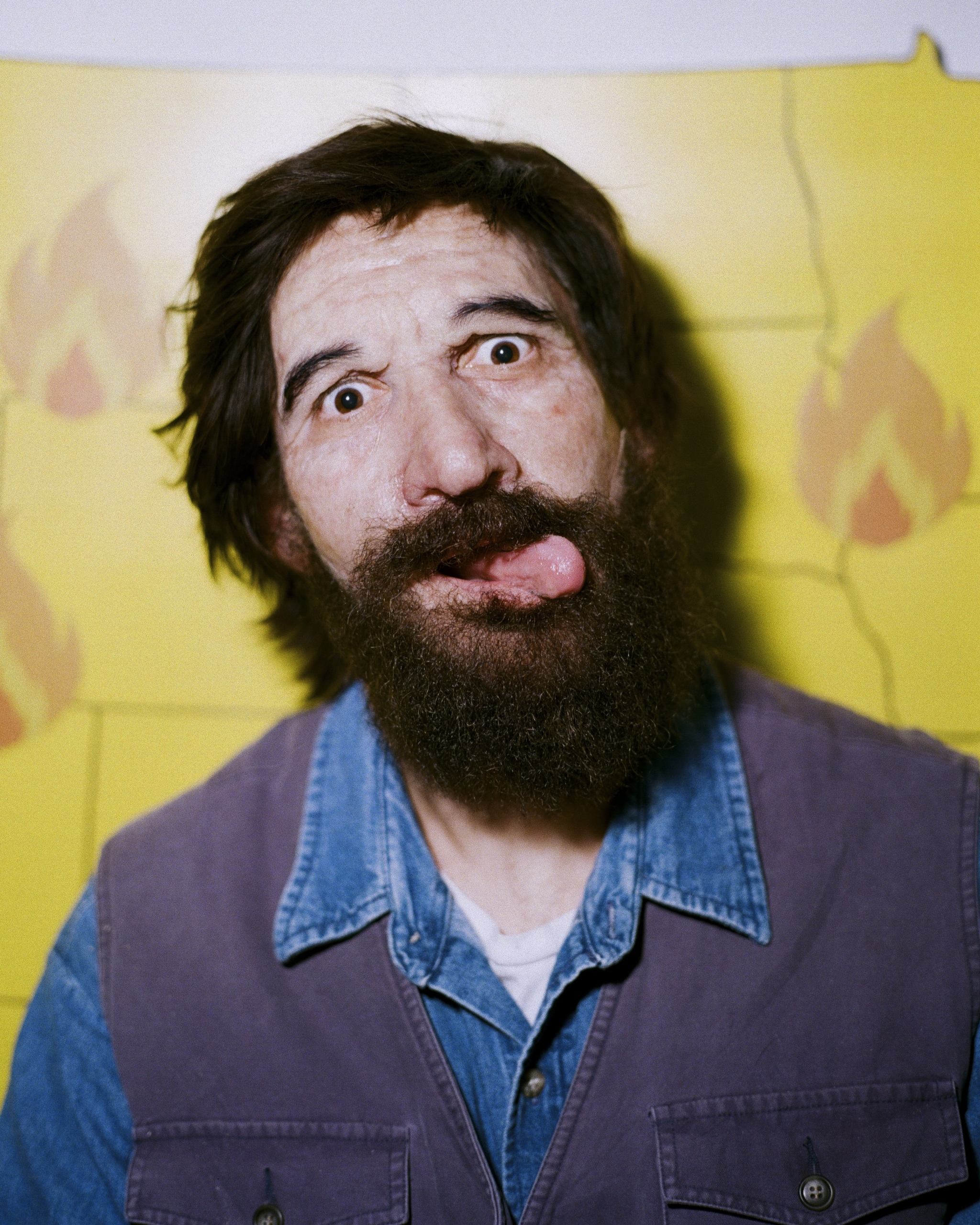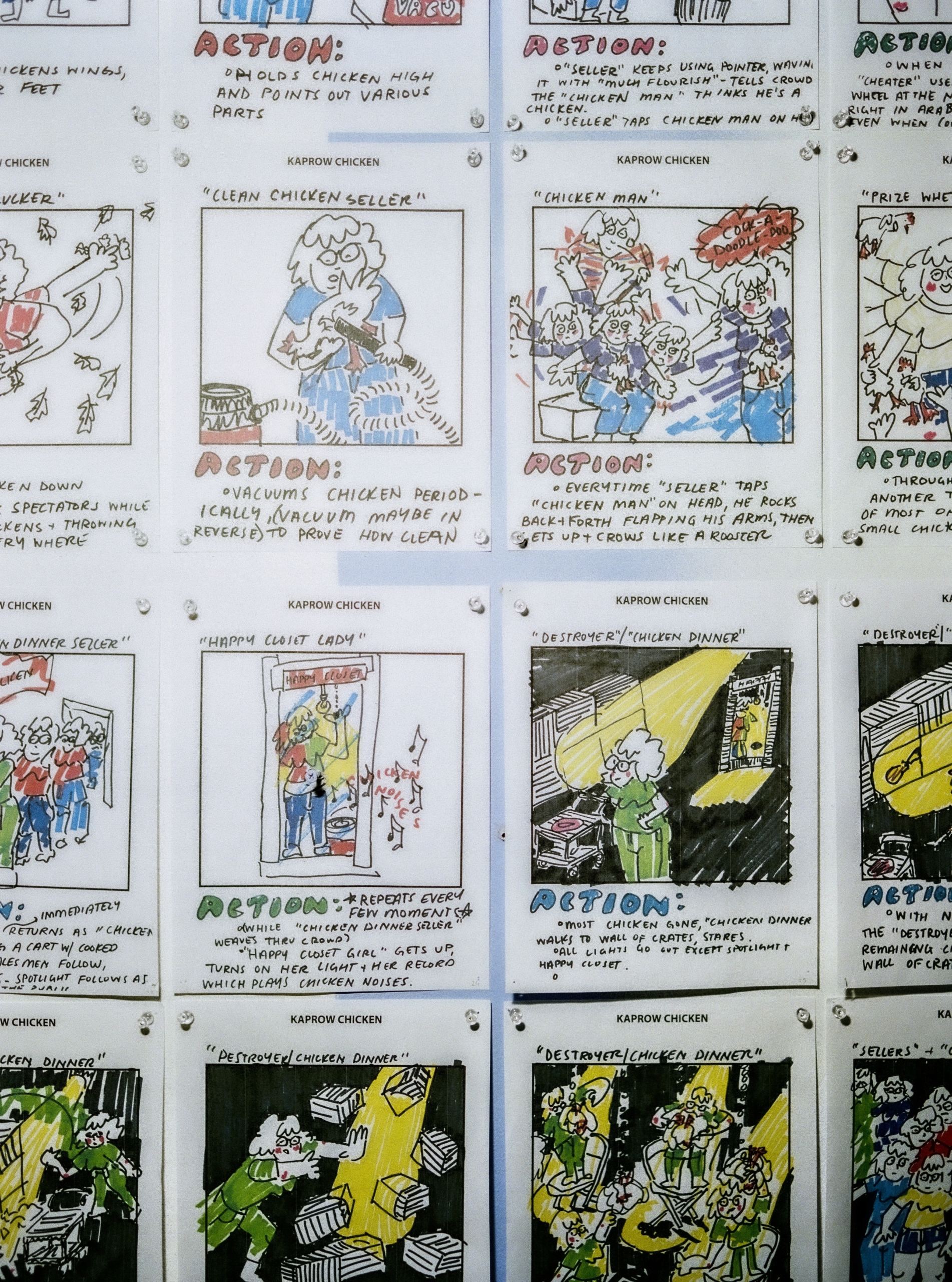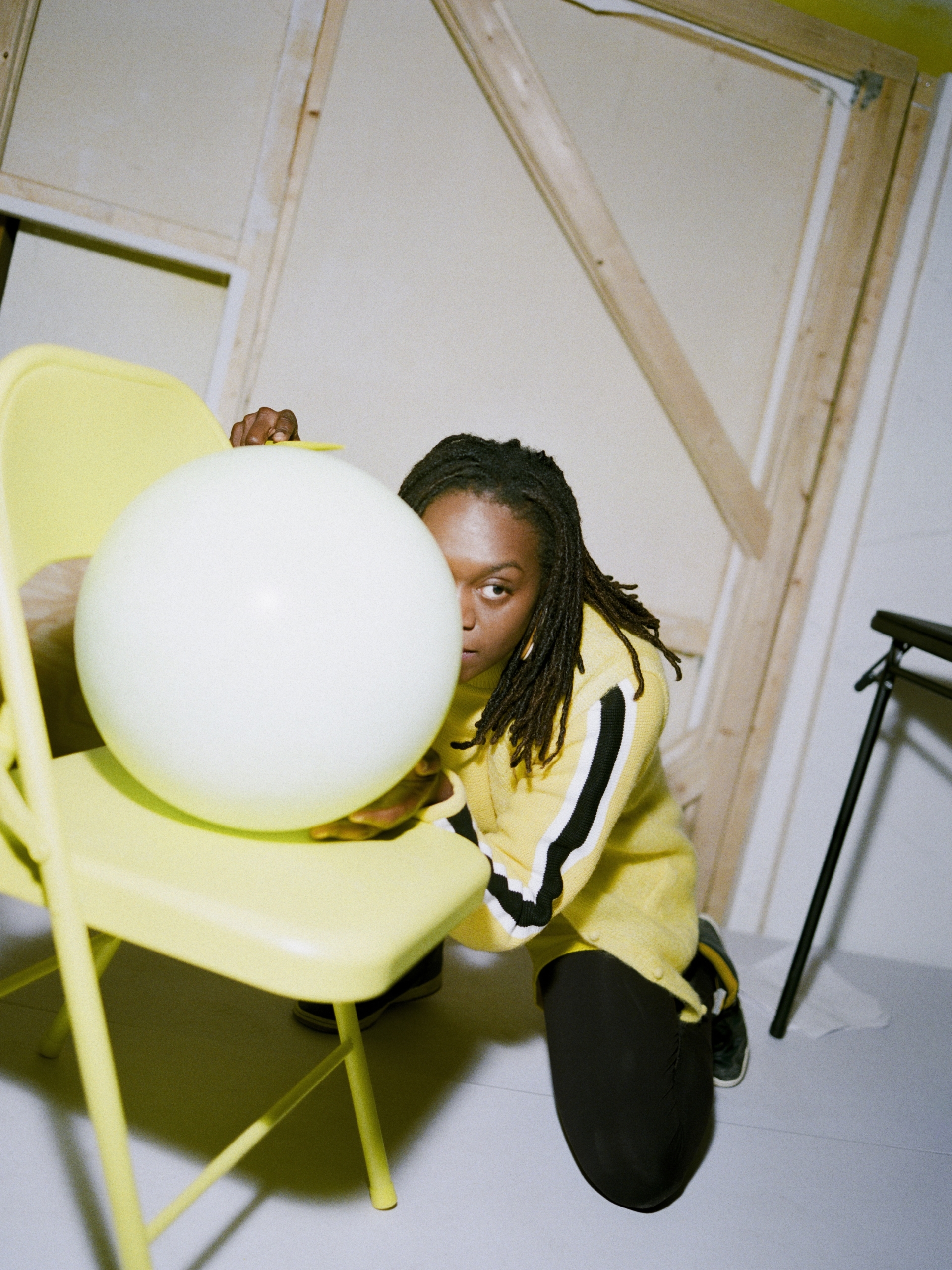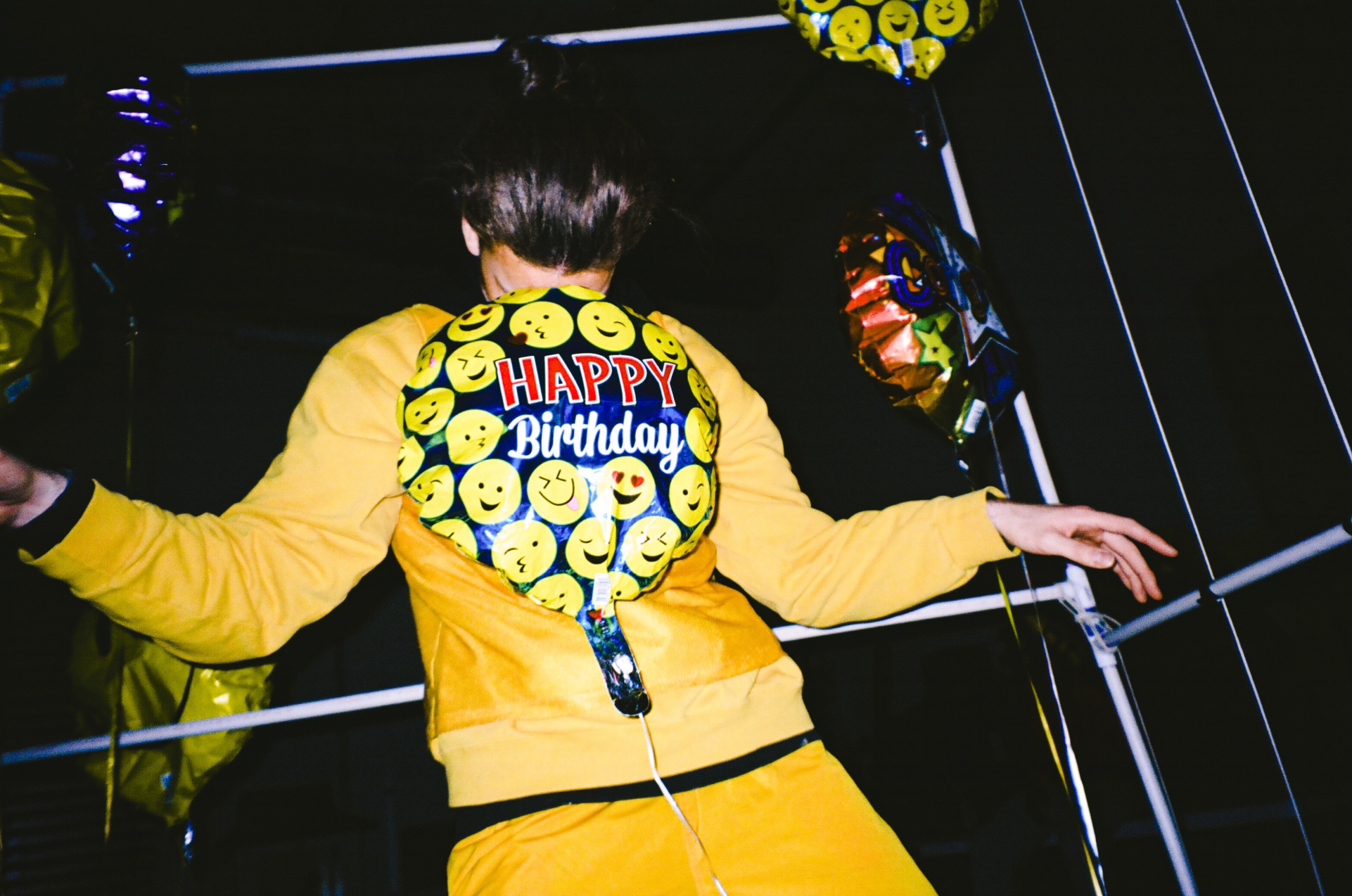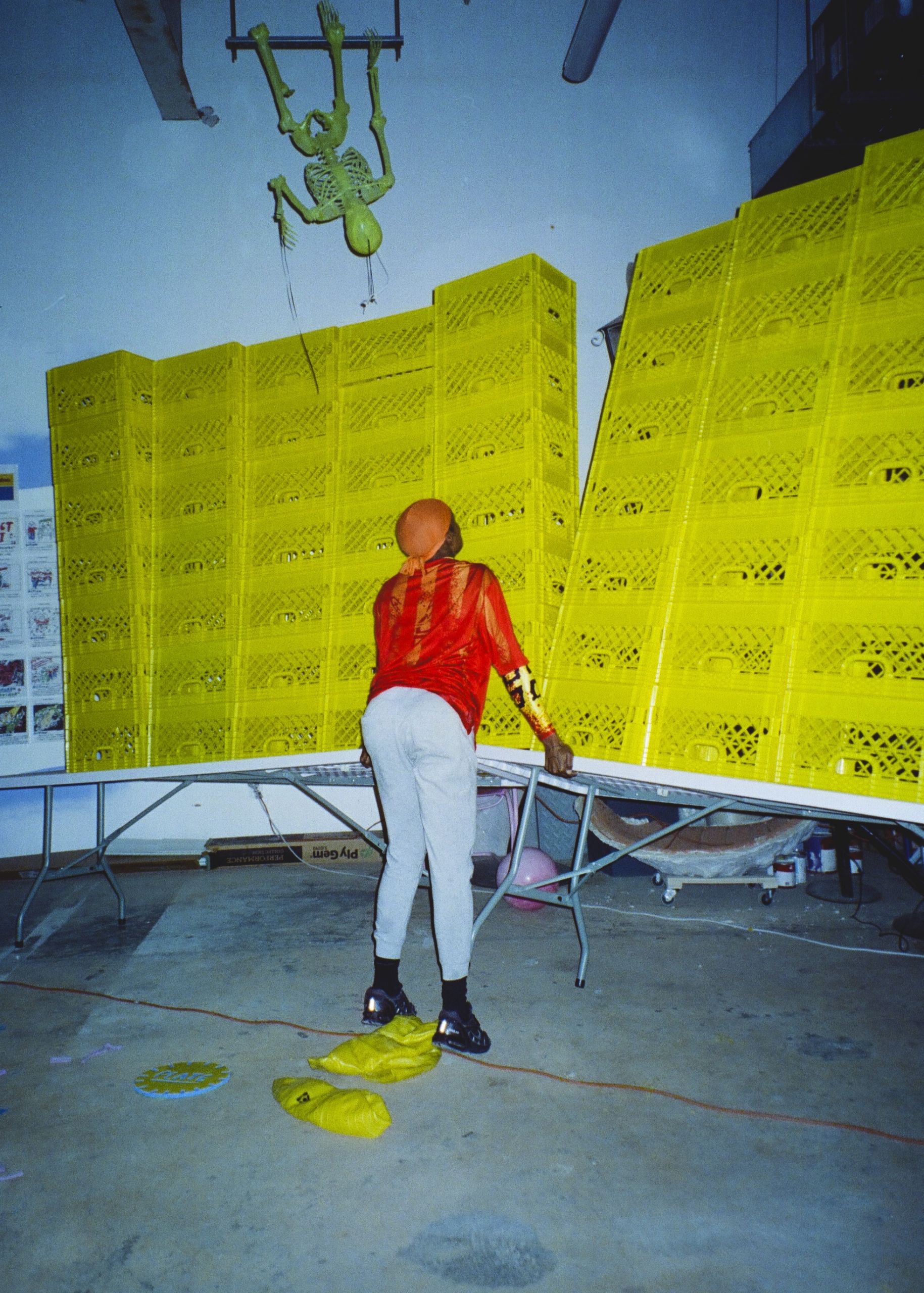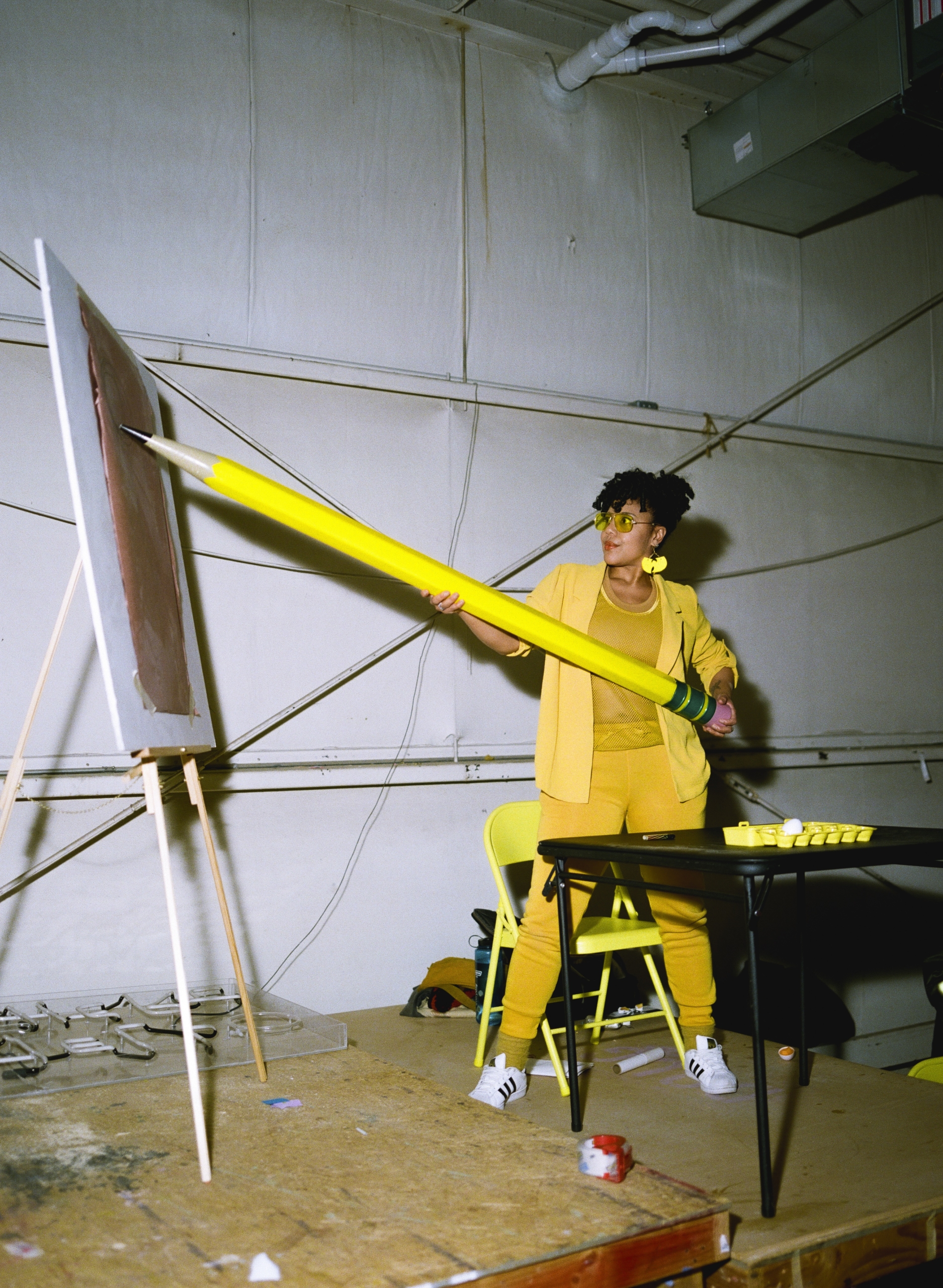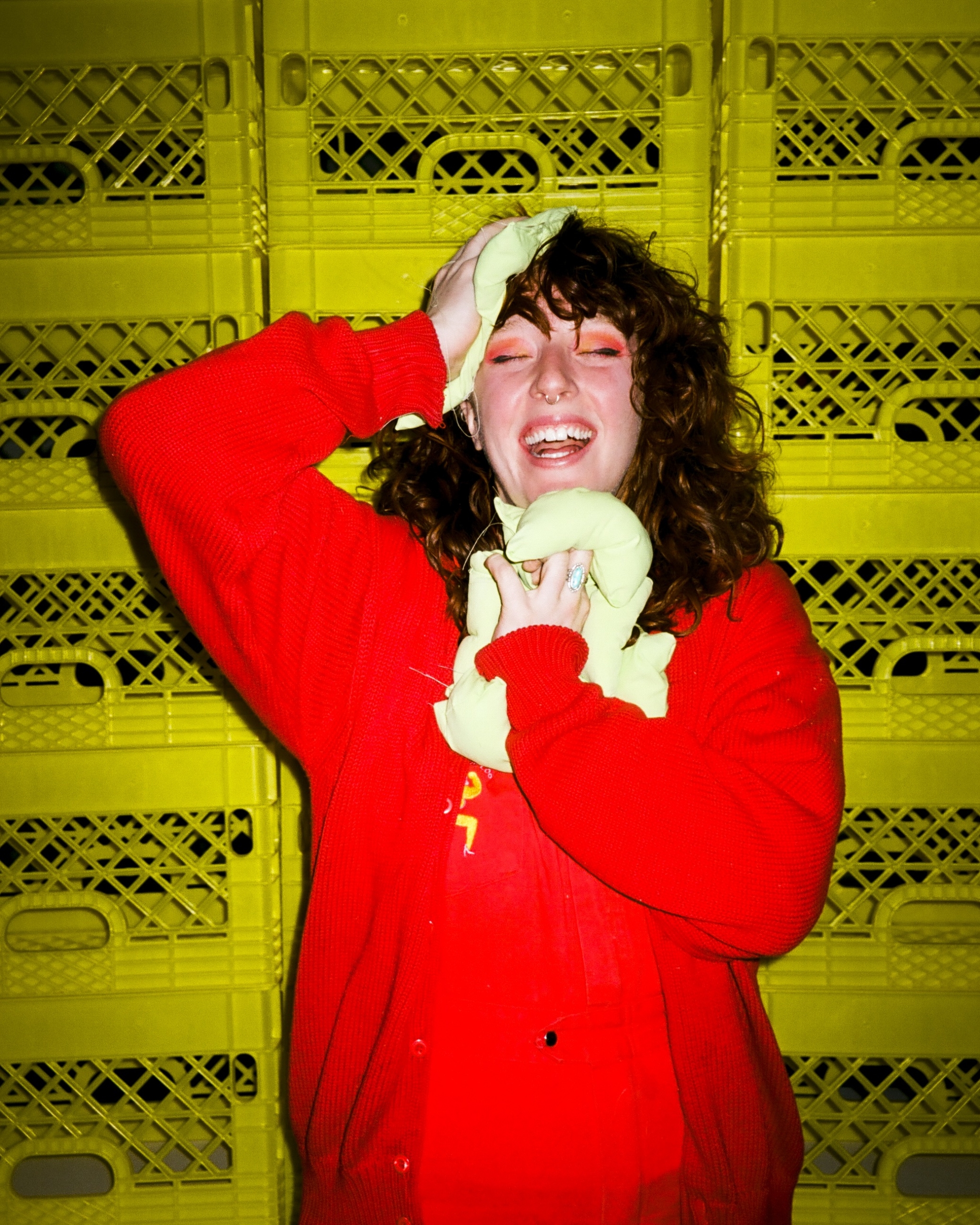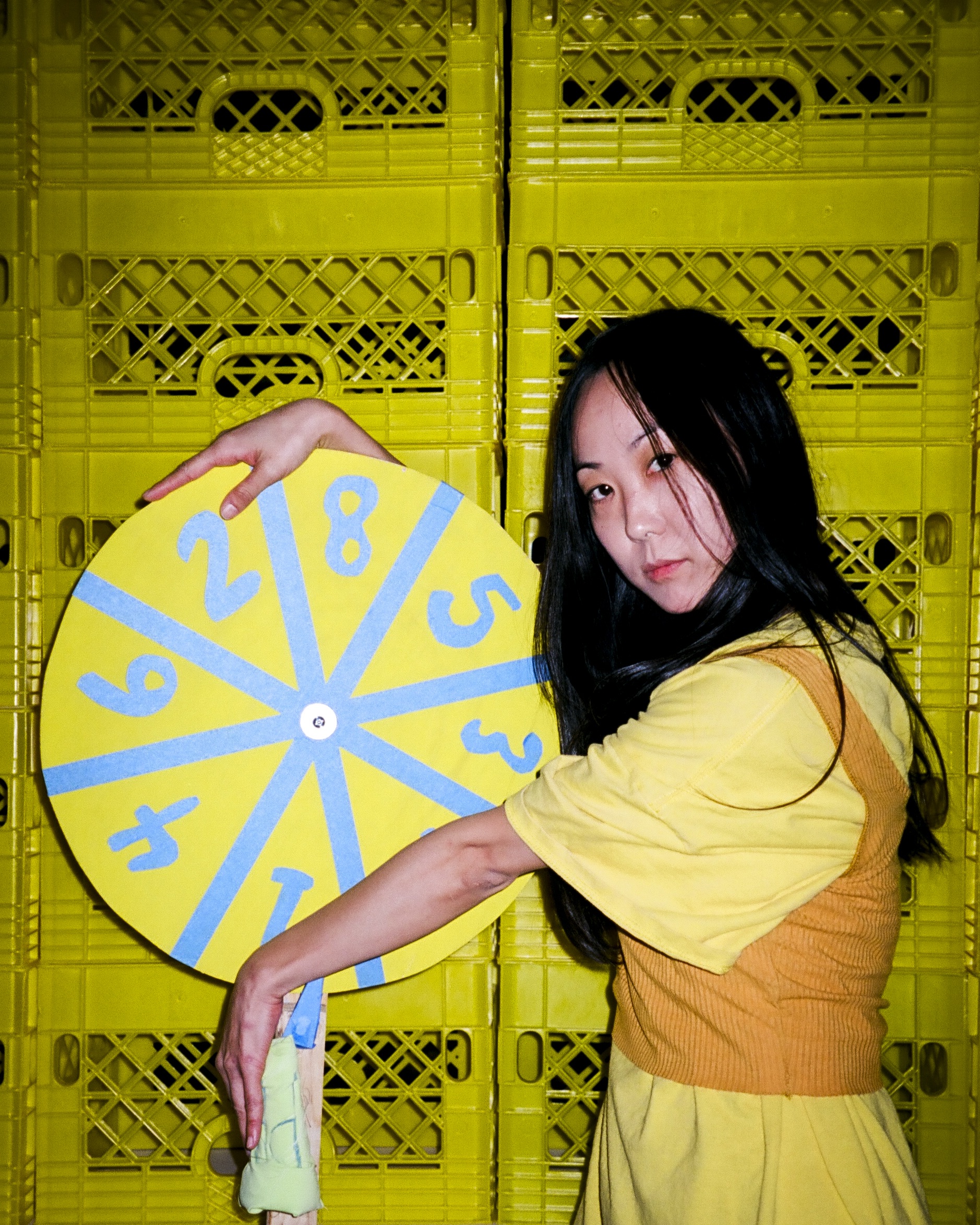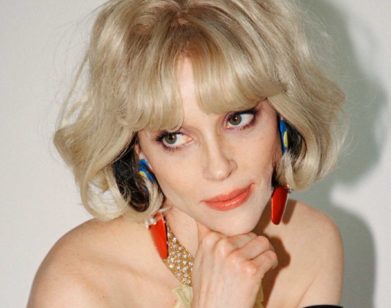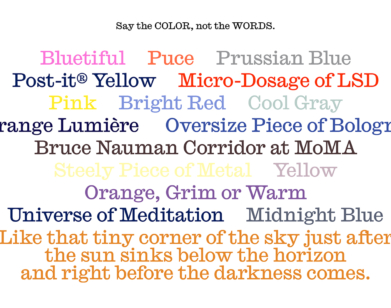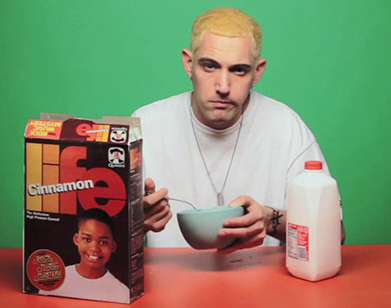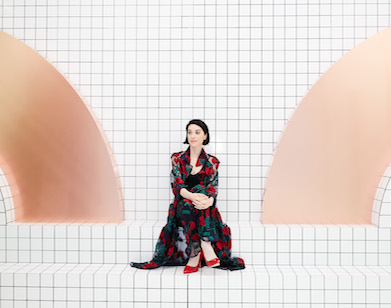Artist Alex Da Corte Plays Chicken With St. Vincent
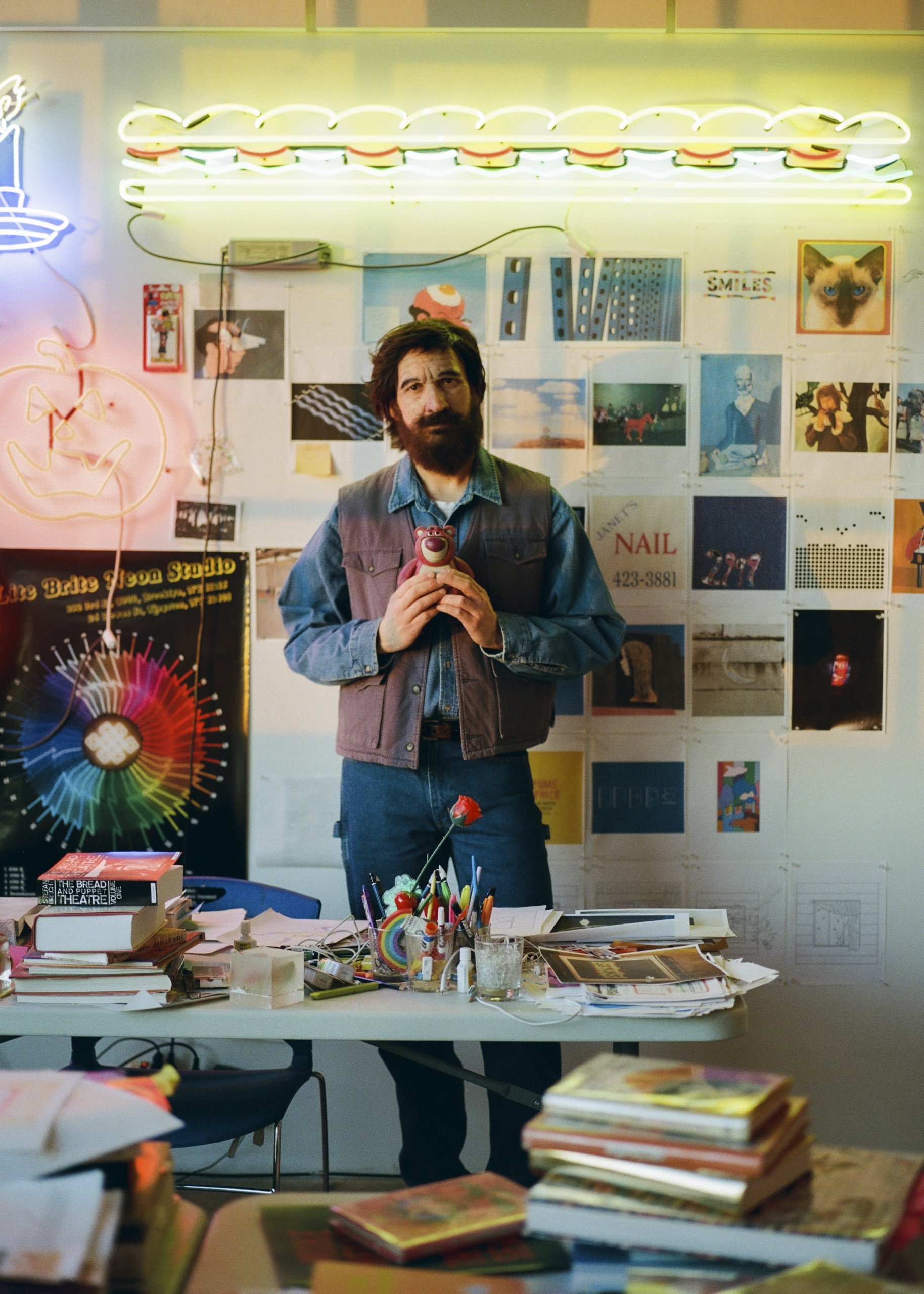
This isn’t what Alex Da Corte normally looks like. No, this is what Alex Da Corte looks like after eight hours in hair and makeup, after the addition of a prosthetic nose, lips, forehead, cheeks, eyes, and beard, all of which serve to transform the 39-year-old, Philadelphia-based artist into Allan Kaprow, a 1960s art Happening pioneer who died in 2006. In Da Corte’s roving, acid-surrealistic, hyper-pop career, he has taken on a diverse range of identities—dressing up in his videos as everyone from Eminem to Mr. Rogers, from the Wicked Witch of the West to Pink Panther. But Kaprow, an iconoclast known for expanding the democracy of arts by inventing the notion of a free, communal, improvisatory art form erupting in the public domain, is a challenging project all its own.
A few years back, Da Corte was approached by a curator with the idea of “reinventing” a particular Happening that took place in Philadelphia during what is largely believed to have been the first East Coast exhibition of Pop Art. On November 7, 1962, Kaprow raised fowl hell with his work “Chicken,” which involved a group of performers in a carnivalesque environment doing all sorts of questionable activities with live and boiled chickens and their eggs; at one point, they even set fire to a nine-foot effigy. It was a provocation meant to shock the audience (and perhaps make lifelong vegetarians out of a few of them, especially considering that a live chicken was vacuumed on stage). Now, on March 5, 2020, Da Corte, disguised as Kaprow, will reinvent (not re-stage, not reenact, not resurrect, not recreate) this Happening for its hour-and-a-half duration in its original site at the Gershman Y at the University of the Arts. This time, instead of molesting and eviscerating live chickens, the performers will have their way with yellow orbs (made of rubber, foam, plastic, and glass) that represent the moon.
Da Corte’s performance is no art world karaoke. Rather, he has found a way to capture the spirit, rebellion, and social critique of Kaprow’s performance for our own place and time. And he isn’t doing it alone. His collaborators include the artist and choreographer Kate Watson-Wallace, and a team of dancers, performers, writers, and costumers to bring this new incarnation of “Chicken” to life. This past January, as he was feverishly preparing for the event, he spoke to his friend Annie Clark, best known to her fans as the musician St. Vincent, about the trials and treasures of bringing this definitive, difficult performance to life in 2020.
———
ALEX DA CORTE: Hey, Annie. What have you been up to?
ANNIE CLARK: Well, two nights ago I played with the remaining guys from Nirvana at a charity benefit, and I was so hungover yesterday that I watched about 12 hours of the old Rod Serling episodes of The Twilight Zone.
DA CORTE: One forgets that so many narratives and storylines on that show were lifted by other movies. Did The Twilight Zone help you recover?
CLARK: You know what? It did. I know this probably sounds privileged in a lot of ways, but sometimes the only thing that will cure too much stimulation for me is when I don’t leave a bed for 24 hours. I think it’s born of being on tour. On those days you’re so tired that you just stay in bed and watch whatever.
DA CORTE: Don’t you think binge watching is comforting? It’s like how I don’t mind listening to one song on repeat for 15 hours.
CLARK: I kind of know that about you. Over the years you’ve sent me songs that you were making work to. And it’s literally one song. Or, I guess, maybe it’s a whole Fiona Apple record.
DA CORTE: Definitely the whole record. But those songs and TV shows do the same thing. It’s like a blanket or soup or something.
CLARK: They’re deeply restorative. Great music and great films just make everything better. So what are you working on right now?
DA CORTE: It’s a reinvention of a Happening that Allan Kaprow made in 1962. I’ve been cooking it up for a while. Are you familiar with Happenings?
CLARK: Ish.
DA CORTE: In the ’50s and ’60s and onwards, Kaprow was doing these sort of singular moments where art was taken to the streets, or to the public, outside of the usual capitalist structure. A lot of times his Happenings were allegorical. They were actions to spark one’s way of thinking about things, in the round, off the wall. This particular one I’m reinventing was called “Chicken.” It was closer to an absurdist play, an hour and a half long with a lot of props and a lot of people involved.
CLARK: How have you been working on that in a day-to-day way?
DA CORTE: I’m making all the props, kind of reimagining how they might be impactful today versus in 1962. When it was originally performed, they used live animals. It was a slaughterhouse. So that’s not happening anymore. I’ve thought a lot about how I could make something complicated and problematic again, what’s the worth in doing that, and what kind of steps I should take to make sure that it stays contemporary.
CLARK: It really comes down, then, to trying to take something and rethink it in a new way.
DA CORTE: Yeah, like The Twilight Zone. You could probably watch al- most any movie or show from that time, and if it hasn’t been remade al- ready, it could provide you with some kind of inspiration for some- thing to remake in this time, in an era of replicas.
CLARK: I’m imagining that a part of the original intent behind a Happening was provocation. In these Thought Police–y times, what kind of provocation are you able to do?
DA CORTE: This original performance—I don’t even know if you’d call it performance—it was the closest to theater that I think Kaprow got. But it seemed very ad hoc. The score [the term used by Kaprow to describe his detailed description of a particular Happening] was written ahead of time and functions in a sense to map out the action. It was very clear and rigorous and deeply democratic in that anyone could take it and do it themselves. But of course, the people who watch over his work and estate understand that these things don’t always age well. They’re not possible to copy. So there’s celebration in reinventing it, and an awareness of using that word instead of “remake” or “re-stage.” We are reinventing in order to be new now, and I like that because it gives the work a certain kind of attitude that pushes against this idea that we should be checking ourselves at all times.
CLARK: I can’t think of a better person to embark on this. Your work manages to combine the absurd with the beautiful, and also has a lot of heart in it. I feel like that’s really threading the needle. Very few people can pull all of that off.
DA CORTE: This project is a challenge because it’s not something that I would gravitate to on my own. The curator, Sid Sachs, asked me a couple of years ago, and I agreed. I went to the school where this was performed in Philadelphia, so I know the venue and the curator is an old teacher of mine and I was just excited to try it.
CLARK: Say yes and jump in. I say yes all the time, and it’s partly over that excitement you just described. You get more excitement out of saying yes to things than saying no, in my experience.
DA CORTE: That’s what this curator told me. My work isn’t like Kaprow’s work, but it’s nice water to his oil. He said that there would be conflict, but that the conflict would probably do me good or at least take me out of my comfort zone. This will be my very first live performance. Do you have any tips?
CLARK: I guess just stay excited because there’s nothing like feeling, “Okay, the train is running and there’s no way to get off…. Here goes.” No matter what anybody throws at you, you just have to react honestly. It’s a the-show-must-go-on kind of mentality.
DA CORTE: Do you remember your first performance? Maybe it was musical theater? I’m just assuming you’ve done musical theater.
CLARK: I’m a bit hurt you would assume that, but you are correct. [Laughs] I did musicals as a chorus girl. I couldn’t dance, so I was always sort of half on stage, half off, you know what I mean? You’re kind of dancing behind the curtain half the time. But I definitely remember my first time playing music—getting up there with a guitar and singing. It really is the most terrifying thing. I still get scared. I think there’s a distinction between musical theater people—who really want to be the center of attention—and the rest of us who really love making things but aren’t necessarily the people who walk into a room and say, “Hey everybody, gather around.”
DA CORTE: But you turn it on. I’m thinking of the last tour I saw of yours where it was just you on a gigantic stage. Where does your brain go at that moment?
CLARK: It goes to a place that is like, “Anything is possible. Anything could happen.” It’s thrilling. It’s so scary every time, but it is absolutely thrilling. I can’t live without it.
DA CORTE: I’ll have a mask on, so that helps.
CLARK: How are you going to deal with the actual chickens in the show?
DA CORTE: I’ve been working on readapting this script with the artist Rosalyn Drexler, who has been making work since the 1960s and is also a playwright. The script is essentially a bunch of people selling chickens or sort of proposing the best ways that a chicken could be used. You have to imagine that this theater is a bit like a carnival or a state fair. And what these people are describing and doing to the chickens is really exuberant but also really violent and problematic. I’ve taken all mentions of chickens and replaced them with the word “moon” or the word “sky.” So now what they’re selling is the sky, or the idea of space or ether. Instead of chickens there will be these beautiful yellow spheres. They’re like stand-ins for the moon.
CLARK: Oh, I love it.
DA CORTE: In some parts there’s this idea about yolk, or Chicken Little. There’s still this idea of dealing with something that’s commodifiable, something that has a life cycle. But now, 50-something years later, we’re at a different place. What we’re trying to commodify has become a war of grasping for the space beyond what we can touch or pull apart or eat. No animals will be destroyed, so that’s really great.
CLARK: They loved a little physical violence in the Fluxus movement, didn’t they?
DA CORTE: They were always pushing and dragging people around, covered in paint. There was something beautiful about those brief, radical actions that were also largely undocumented and unnamed. I miss that in work now. I want to see something that feels like a surprise. I want to hear a new sound, or see something new. But I also think that can happen without hurting anyone.
CLARK: I’m reminded of Yoko Ono’s “Cut Piece,” where the audience cut o her clothes. Le to our own devices, humans will utterly destroy one another. It’s like the Stanford prison experiment. That was also a performance. They weren’t just science experiments. And I think replacing chickens with the moon adds some magic to the work. Maybe The Twilight Zone has got me thinking about that particular period of time, but Kaprow’s work was made not so long after a major war. And they were living in the specter of the atomic bomb. One could read those fears into that piece.
DA CORTE: I think Kaprow wanted to have a voice that was outside of the galleries asking, “What is life? What’s really happening here?” I see that now in different performers who are trying to shake things up and be in the world. I think now the new terrain is the ether. I don’t know how one would begin to claim or address that. Not coincidentally, Kaprow’s piece was part of the first Pop Art show on the East Coast. They were looking at this new horizon and this undeniable way of making things using populist goods, and the whole idea of pop. And he was ahead of us saying, “Maybe this is a problem.” But that was then. How do you even begin to make something new and vital now?
CLARK: For me, more and more, I think, “What matters is the song.” It’s not so much about a new sound. The thing I go back to is, “Is it a good song? Does it resonate? Does it mean something?” And that meaning doesn’t have to come from a lyric. It could be Dada, it could be absurd, but it just has to feel like something.
DA CORTE: If I had to put it into words, I guess I want this piece to feel strange or free or surprising. Doing the work is like stepping forward but not being clear on where your foot is landing.
CLARK: Do you tend to like when artists reinvent or “cover” a previous work?
DA CORTE: Well, take a Nirvana song. It holds a weight in space. And you could take that and make it new and fresh and hot. I’m thinking of your last album, Masseducation, and how you did some covers and remixes of your songs. Then there’s someone like Michael Haneke remaking Funny Games, first in German and then in English. There’s something in there about how even if you tried to do the very same thing the next day it would be different.
CLARK: I think covering anything is a testament to its longevity. A Nirvana song doesn’t get old. It still resonates. There is something unassailable about the work, and that’s why they survive. But music is different. I can’t think of many examples of artists covering other artists.
DA CORTE: Sturtevant made a whole career out of it, remaking works by Andy Warhol and Paul McCarthy and others, sometimes within the same month or year. She even remade the whole Claes Oldenburg store that he did in 1961, as if to ask, “How is this different because I’ve done it?” It really makes you look at understanding the author and the context and what ground it is you’re walking on, along with what has come before you. It was a really defiant thing. Now people cover songs and albums the nanosecond they’re released, and they’re sung at karaoke. But you’re right, it happens less often and less immediately with art.
CLARK: I want to get back to this idea of provocation. It seems like we’re in a strange time where there’s an edict to make positive work and write things that are overtly empowering. But the conundrum for me is that, in my experience, in my enjoyment of art, what’s empowering is to have someone talk for real about the human condition. And that is ugly and contradictory and messy. So I feel we’re in a strange time where there are a lot of good intentions in the name of progress, but…
DA CORTE: Can you bring that heat to the table without having to hurt any animals? How do you bring a complicated, messy, completely fraught portrait of the moment 57 years later that isn’t, in a way, any cleaner or wiser, especially when we’re on the brink of so many awful and heinous things? How do you mirror that? I think to mirror this world we’re in now with digital warfare and buying and selling, you need to make the story using new coats, a new vocabulary. I mean, in a way, this performance is a big fucking mess. But there’s beauty in that mess. There’s beauty in how deranged and violent it is. But enough about me—what are you working on right now?
CLARK: I’m writing, which I both love so much and fucking hate! Writing really comes back to this idea of covers and everything we were talking about. You have to be able to know a lot of other songs, and take them apart. A lot of writing, for me, is like dissecting frogs. And then there’s the other part of it, which is the stumbling upon something good after boiling away all the really embarrassing, bad ideas. How necessary is it for you to always be making work?
DA CORTE: I don’t think I’ve taken a day off in ten years. I don’t know if days off are something I even want. I like making work. It’s what I want to do with the time I have here. If the ideas are there, I want to chase them down. There’s a demon inside me that possesses me to make work into, or try to untangle, whatever is there.
———

This article appears in the March 2020 issue of Interview Magazine. Subscribe here.

